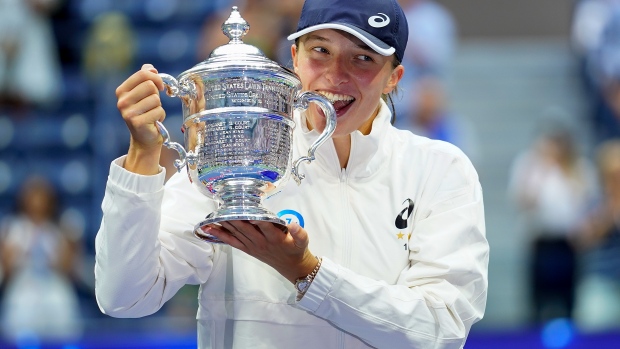Sep 6, 2023
Awareness still at disadvantage in decades-long battle for tennis pay equity

Written by: Crina Mustafa
Follow: @crinamm
As the U.S. Open rumbles toward its finals this weekend, artwork and gifts at the USTA Billie Jean King National Tennis Center in Queens, New York continue to remind the viewing public of the beginnings of the pay equity conversation in sports. It was King herself, who in 1972 received less than half of the prize money afforded to the men’s U.S. Open champion Illie Nastase for her championship, and triggered the debate with the simple words: “This really stinks.”
By the following year, the purses for men and women at the U.S. Open were equal, and the three other majors – Wimbledon, the French Open and the Australian Open – eventually followed suit, with Wimbledon being the last in 2007. But these events only account for tennis’ most glittering moments. While the tennis majors set the tone for gender pay fairness in the entire sports world, the professional tennis tour continues throughout the year, and payouts continue to be higher on the men’s side. Tournaments at the 1000, 500, 250, and challenger levels still have many sets to play to reach pay equity.
Canadian tennis player Denis Shapovalov became aware of the issue when he started dating his now-fianceé, Mirjam Björklund, a professional tennis player from Sweden. In an article he authored for The Players' Tribune, Shapovalov spoke about the difference in pay between Association of Tennis Professionals (Men) and Women’s Tennis Association players on the tour for the same-level tournaments. What stands out is the unique circumstance he was in to realize just how big the gap in women’s tennis is, even as a player himself.
“I still don’t understand the thought process,” he wrote. “Some say women don’t sell as many tickets, but when I go to matches the stadiums are full. I took a picture of the stands when Mirjam was playing Daria Saville at the WTA 250 in Washington, D.C., in August last year. It was packed. The game was crazy intense. The quality was unbelievable.”
Valérie Tétrault, who has worked at Tennis Canada for over 12 years, including as director of the National Bank Open held in Montreal last month, played the sport professionally from 2006-10. “I think I was a little bit conscious of that back when I was playing, but it was definitely not something that we were talking about as much as we've been talking in the last couple of years,” she said. Tétrault also mentioned that it is vital for players to unify and help spread the message, just as Shapovalov did.
There is a lack of awareness surrounding pay equity in tennis. “Fans are constantly told that Grand Slams are the only thing that matters, and so many fans tune in for a couple of weeks at four different points of the year and then tune out,” said tennis journalist Vivek Jacob.
Jacob has covered tennis since 2016 and uses his platform, The Sports Student, to educate fans on the ins and outs of the sport. As a fan, he never really noticed the pay disparity, as it was never a conversation on broadcasts after the matches. “Once I did notice it, then I mainly saw the debate being raised by players on the WTA tour, followed up by ATP players voicing their opinion,” he said.
The WTA Tour is still moving towards pay equity at its various levels, including the Plan For Pay Equity By 2033 initiative, which sees joint 1000 and 500 events gaining equal prize money and expanding several tournaments. As the tournament director in Montreal, Tetrault will also help oversee their expansion, which was announced by Tennis Canada earlier this year. “With our tournament extending to now a 12-day main draw, it makes a big difference, especially when talking about growing revenue,” she said. Following the tournament's expansion, they also expect to reach equal prize money in Canada by 2027.
According to Ticketmaster, the National Bank Open hosted a record-breaking 219,000 fans at the Montreal event featuring women’s players, while Toronto’s men’s version welcomed 175,000 people.
Initiatives towards fair pay on the tennis tour are starting to come into effect. As the TV deals, ticket sales, and overall marketing continue to grow, the WTA tour can finally catch up and receive the treatment their players deserve. An initiative that began over 50 years ago, started by a great player, King, continues on today. Who leads the charge? The athletes themselves.